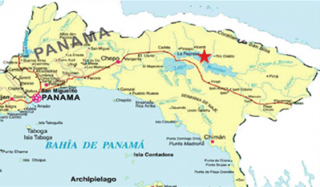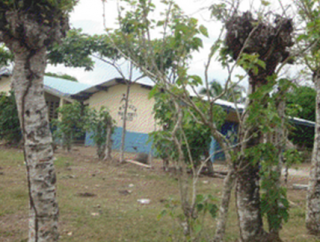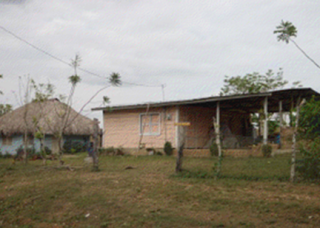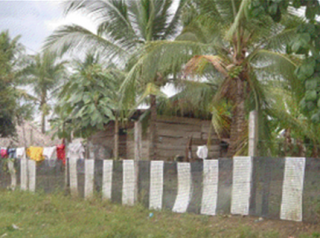Wagandi, Panama
![]()
![]()
![]()
![]()
![]()
![]()
![]() Click on Programs to learn more about their work in this community
Click on Programs to learn more about their work in this community
General Information

| Population* | 190 |
| Number of homes | 32 |
| Avg # of people per home | 6 |
| Electricity | Small Solar Lamps |
| Corregimiento | Comarca Madugandi |
| District | Chepo |
| Corresponding Health Center | Centro de Salud - Torti |
| Distance from compounds | 20 minutes |
| Road conditions | Below average, dirt road |
* Population does not reflect how many patients will be seen on medical
brigades as many people from surrounding communities come seeking
Medical Brigades medical attention.
Expressed Needs and Capacities
The community has expressed several strengths. Many skilled craftswomen live in the community
who dedicate themselves to sewing the traditional Guna Mola. Moreover, the community has strong
agricultural and fishing resources, as one can arrive within a reasonable amount of time to the Lago
Bayano from Wagandi. On the other hand, proper waste management, more specialized
agricultural training, and improving nutritional levels as well as an explicit interest in learning more
about greenhouses remain among the top needs expressed by the community.

|
Wagandi's educationl system includes a preschool with one bilingual teacher (Spanish and Tule, the indigenous language). The community constructed the school itself. In addition to the preschool, the closest primary school can be found in another community within walking distance. For secondary school, students have to travel around 20 minutes (by bus or taxi) to the nearest center in Tortí. Approximately 58% of the community can read and write. A majority of the older community members do not speak or understand Spanish.
|

|
Wagandi has recently instaled a pump-based aqueduct system. Nearly all of the community is connected to this system whereas several households are connected to a system in a neighboring community; however, at the time this report was written, the community did not regularly use the aqueduct due to the problems with the pump and the cost of the diesel fuel needed to run it. Consequently, a majority of the community members still collect their water for bathing, drinking, and washing from the river that runs alongside of the community. Any water that comes from the aqueduct is not purified; however several families boil their water when collecting it from either the river or the aqueduct. Currently, the community has a Water Committee that is in charge of the aqueduct maintenance and cleaning the reserve tank.
|
Wagandi does not have a Centro de Salud (health center). There are several neighboring communities that have health centers such as Piriati that can be arrived at within 15 minutes by bus. Otherwise community members go to the health center in Tortí. In terms of health care assistants, the Water Committee also serves as the Public Health Committee and three traditional Guna midwives still practice in the community.
The most common illnesses seen by community members are intestinal parasites, diarrhea, and the common cold. Around half of the community members have pit latrines that were built under a government program. Although, due to design flaws, some of the latrines have caved in and many are at risk for overflowing during the rainy season. Very few households have gas stoves and a majority of the inhabitants have dirt floors in their homes. The houses are very traditional and constructed out of wood with penca (palm tree leaf) roofing.

|
For the males in the community, the main forms of employment are agriculture on privately owned farms. Members cultivate corn, rice, yam, and plantains either to sell or for their own consumption. The women mainly dedicate themselves to the household and many sew traditional molas. Several families raise chickens for their personal consumption and families also fish at the Lago Bayano, where surpluses of fish will be sold depending on the size of the catch. Local businesses in the area consist of four small stores that sell staple foods and snacks. Access to credit is quite difficult to come by for nearly all of the members of Wagandi, which means that small business and future entrepreneurs face barriers in obtaining start-up capital or expanding their operations.
|
In this particular region of Panama, no recycling or trash collection system has been established to aid community members in managing their waste. Wagandi has not reported any locally based initiatives to reduce or reuse waste and community members burn and/or burry trash as the main form of disposal. Families in general do not use any type of fertilizer, neither organic nor otherwise. There is no environmental committee in the community.
While there is no lawyer in Wagandi, there is access to legal services in Panama City and/or Guna Yala. However, the locally based authorities resolve most of the legal issues that occur as the community is located within the autonomous Guna territory of Madugandi.
The community of Wagandi lies within the Madugandi Guna territory, where the Guna have officially held semi-autonomous status since 1986. The Guna received their partial independence from the Panamanian state in 1925 and this particular territory makes up one of several different semi-sovereign indigenous zones located throughout Panama. Locally, within the communities as well as amongst other Guna territories, their self-governing structure means that they rely mainly on a traditional hierarchy to regulate community affairs. In individual communities, the first Saila, or the community chief, delegates administrative responsibilities and acts as a moral and political leader. As the Saila represents the community and holds the authority to make decisions, Global Brigades must always look for his (the Saila is nearly always male) approval whenever doing any type of intervention in the community. In Wagandi in particular, the Saila also relies on a secretary and several community watchmen as well as a second and third Saila to assist with his duties.
The Health Ministry (MINSA) and The Ministry of Agriculture and Livestock Development (MIDA)
Medical/Dental and Public Health are currently working in the community.
Source of information: Key informant interview and 2010 government census
Date of interview: August 7th, 2012
Last updated: September 25th, 2012